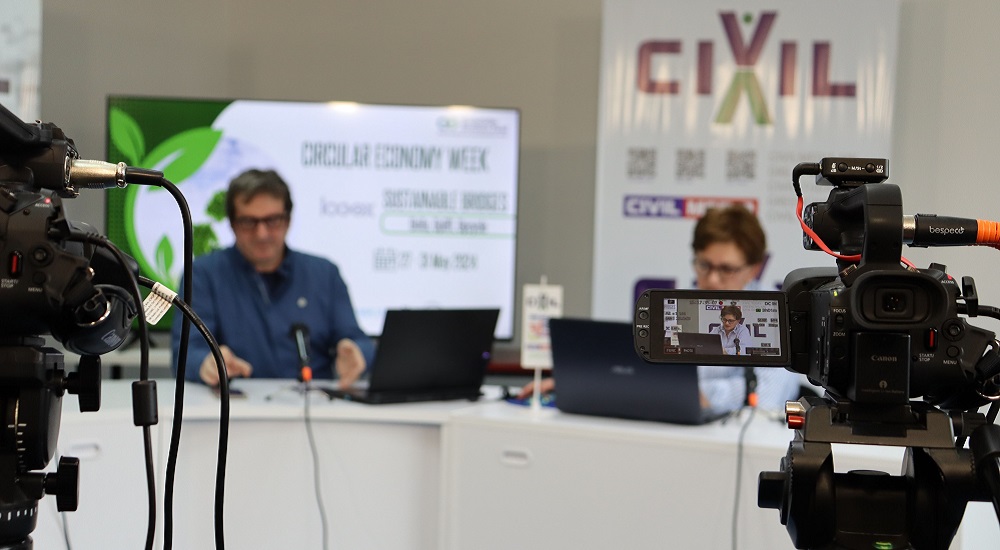By Xhabir Deralla and CIVIL Research Team
The analysis “Circular economy perspectives during war and insecurity” explores how the principles of a circular economy can be upheld and advanced even amid the chaos and destruction of wars and conflicts. This is a summary, while the full version of the first draft of this analysis will be published soon, and it will be submitted to partners and governments across the region and globally, as well as to relevant international bodies and organizations.
Impact of the Russian aggression against Ukraine: Ecocide
The analysis highlights the severe environmental damage caused by the Russian aggression against Ukraine. This includes the destruction of natural parks, reserves, and forests, leading to a significant loss of biodiversity and an increase in greenhouse gas emissions. The conflict has resulted in extensive environmental damage, amounting to billions of euros. This ecological destruction underscores the need for resilient and sustainable practices even during times of war.
Impact of Conflicts on Green Transformative Policies and Practices
Wars not only cause loss of life and trauma but also devastate natural, industrial, social, and cultural resources. Conflicts disrupt supply chains, making essential raw materials scarce and expensive, thereby hindering circular economy efforts. The financial strain of war diverts resources away from sustainable projects, while environmental degradation further complicates waste management and recycling initiatives.
Policies and Strategies for Mitigating the Impact of Wars and Conflicts on Green Initiatives
Despite these challenges, there are ways to mitigate the impact of wars on green initiatives. This analysis suggests focusing on localized production, resilient technologies, and supportive policies. Strengthening local recycling and manufacturing capabilities can reduce dependency on global supply chains. Investing in resilient infrastructure and adaptable business models can help maintain circular practices during conflicts.
Strengthening the Circular Economy: Five Key Strategies for Resilience
The analysis outlines five comprehensive strategies for strengthening the circular economy:
- The European Green Deal: Aims to make the EU’s economy sustainable by turning climate challenges into opportunities and includes measures to ensure resilient supply chains (Circular Economy Action Plan).
- The U.S. National Recycling Strategy: Focuses on improving the recycling system and maintaining infrastructure during emergencies.
- The UK’s Resources and Waste Strategy: Emphasizes minimizing waste and promoting resource efficiency.
- Nordic Council of Ministers’ Approach: Promotes regional cooperation and innovation to enhance circular practices.
- French Legislation: Enacts laws to eliminate single-use plastics, improve recycling rates, and promote product repair and reuse.
Adapting Global Strategies for Local and Regional Resilience and Circular Economy Development
These strategies serve as guidelines for less developed regions like the Western Balkans. By promoting local, sustainable supply chains and investing in resilient infrastructure, these regions can enhance their ability to withstand disruptions. Fostering public-private partnerships and encouraging innovation in recycling and waste management are also crucial. Additionally, international organizations can provide support and resources to help these regions sustain circular economy efforts.
Recommendations for resilience and sustainability
- Invest in local recycling and manufacturing capabilities to reduce dependency on global supply chains.
- Promote community-based initiatives that support resource efficiency and sustainability.
- Advocate for policies that prioritize sustainability and circular economy principles, even during times of conflict.
- Engage international organizations to support circular economy initiatives in conflict zones.
- Encourage the development and deployment of technologies that can operate effectively in conflict-affected areas.
- Support analysis into materials and processes that enhance resilience and sustainability.
Conclusion
In conclusion, while conflicts and insecurities pose significant challenges to the implementation of a circular economy, they also underscore the critical need for resilient and sustainable practices. By focusing on local solutions, innovative technologies, and supportive policies, it is possible to advance circular economy principles even in the most challenging times. Local recycling programs, resilient infrastructure, and public-private partnerships are vital for building a robust circular economy. Through education and awareness, communities can be empowered to contribute to sustainability efforts, ensuring a resilient and regenerative economic future.

